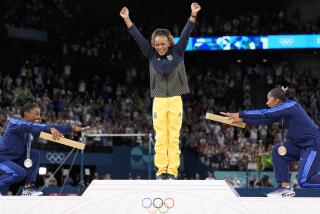BARCELONA ’92 OLYMPICS : Difference Could Be a Matter of Styles : Women’s gymnastics: Three rivals have distinct flavors that will be displayed in the all-around final.
- Share via
BARCELONA — In the end, the women’s all-around gold medal in gymnastics could come down to style.
There is a power-packed tumbler from Houston. A willowy perfectionist from Oklahoma City. And a svelte dancer from Minsk.
Tonight, one of these teen-agers will probably be wearing the gold medal at the 1992 Summer Olympics.
Instead of one favorite, there are three. And two are from the United States, which has produced only one all-around champion in Olympic history--1984 gold medalist Mary Lou Retton.
There is Kim Zmeskal, 16, sculptured in U.S. Coach Bela Karolyi’s Houston gym, and transformed into the 1991 world champion.
There is Shannon Miller, 15, a shy Oklahoma high school freshman who is daring and technically precise.
And there is Svetlana Boguinskaia, 19, of the Commonwealth of Independent States, the 1988 bronze medalist in the all-around and gold medalist in the vault. She also was the 1989 world champion.
Bringing different strengths and temperaments into the competition, the gymnasts make for fascinating contrasts that the judges must sort through.
Zmeskal turns a floor exercise routine into a breathtaking “Rock Around the Clock.” She is perhaps the toughest competitor of the three. Two nights after a tumble from the balance beam nearly ended her chances of reaching the all-around, Zmeskal came back in the team optional final, recorded the highest total, and reached the individual final, where the scores are wiped clean.
Miller has the best blend of grace, flexibility and sheer athletic talent, performing a triple release sequence on the uneven bars. Virtually unknown before the 1991 World Championships, she has defeated Zmeskal four consecutive times in direct competition in compulsory routines.
But her problem tonight is that the gymnasts will be performing the more selective optional routines, where flaws can be hidden and strengths accentuated.
And Boguinskaia is a captivating performer, retaining her place near the top of the sport at an age when most have retired.
Karolyi says Boguinskaia’s time has passed, but she keeps popping up in the standings. Despite a third-place finish at the European Championships, and a weak performance in the CIS selection camp, she led the former Soviets to the team gold Tuesday night.
Other medal contenders are Tatiana Gutsu and Tatiana Lisenko of the CIS, Cristina Bontas of Romania and Henrietta Onodi, Hungary’s graceful performer who has a reputation for cracking under the strain of major competition.
If Onodi can keep control her nerves, she has the potential to steal the gold.
“I don’t really like to peer into the future,” Boguinskaia said of predicting the finish. “Of course, I’ll try to do my best. I’ll try to do my double best. I’ll try to perform in a dignified manner.”
If only it were that easy. There is a history of bad blood in this competition.
At the World Championships a year ago in Indianapolis, Boguinskaia and Zmeskal refused to shake hands on a medal podium. And although the gymnasts exchanged handshakes after receiving their team medals, they keep a wary distance.
The American coaching staff is not exactly a smooth-operating unit, either. Karolyi and Steve Nunno, Miller’s coach, have had a cool relationship since the U.S. trials in Baltimore when Miller was awarded the title on a technicality.
But it was Miller who led the individual scores after the two team rounds. If she stays consistent she could emerge with the gold.
“Shannon beat everyone,” Nunno said. “She is cooking and everyone knows it. As far as I am concerned, Shannon is No. 1, the best gymnast in the world.”
More to Read
Go beyond the scoreboard
Get the latest on L.A.'s teams in the daily Sports Report newsletter.
You may occasionally receive promotional content from the Los Angeles Times.






